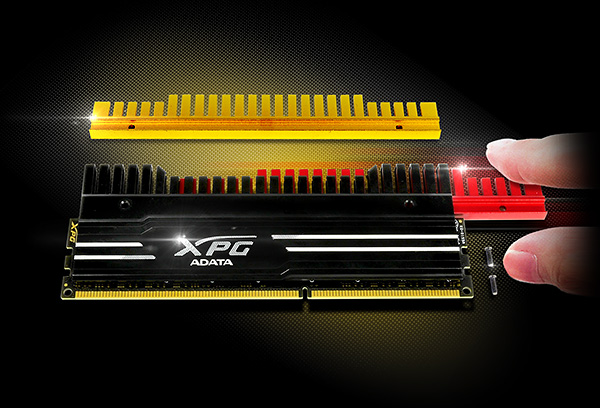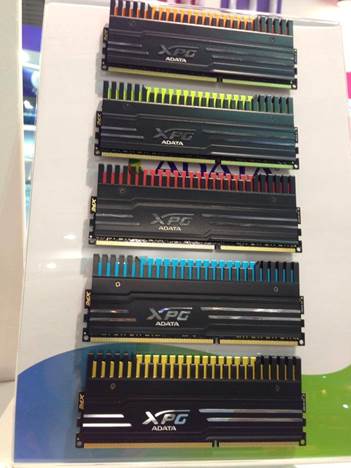ADATA Launches XPG V3 DDR3 Range
by Ian Cutress on July 25, 2014 5:24 AM EST
Despite the talk surrounding the introduction of DDR4 to the market, the volume product for the foreseeable future is still DDR3. We have done a number of memory scaling articles in the past [1,2,3], but due to the resurgence of growth in the gaming segments over the last several quarters, there is still a demand for high speed DRAM, especially those that match the style of the build if the user or gamer wants to show it off at an event. This has caused some of the enthusiast DRAM manufacturers to re-launch their high end modules under new names and new skins, with the option of customization. This lies at the heart of ADATA’s new XPG V3 DDR3 range.
The finned array for the heatsinks can be removed, similar to other high end ranges, and replaced with a custom color. ADATA is saying that the first batches of these modules for retail will include a second set of fins, so users can select between gold and red. There are plans to launch other colors in the future.
Launched SKUs will first be available in gold/red, in either 2x4 GB or 2x8 GB kits, with the following speeds:
DDR3-1600 9-9-9-24 1.50V
DDR3-1866 10-11-11-30 1.50V
DDR3-2133 10-11-11-30 1.65V
DDR3-2400 11-13-13-35 1.65V
DDR3-2600 11-13-13-35 1.65V
DDR3-2800 12-14-14-36 1.65V
DDR3-2933 12-14-14-36 1.65V
DDR3-3100 12-14-14-36 1.65V
All kits will support XMP 1.3, use 8-layer PCBs with 2oz copper to improve signalling, and Thermal Conductive Technology (TCT), which is a fancy way of saying that the DRAM chips themselves are in contact with the heatsink, so the heatsink may be hard to remove depending on the bonding.
With the high frequency modules, it is always worth noting that these are designed for use with Ivy Bridge and Haswell CPUs, and the quality of the memory controller will determine the maximum speed possible. All the Ivy Bridge and Haswell CPUs I have tested, at stock, will easily do DDR3-2933, and should find DDR3-3100 OK as well with a small base frequency overclock. Overclocking the CPU may reduce the peak memory frequency possible, and thus if running an overclocked system, a balance may be needed as well as the expertise/guide to manage that balance. This is true with any high speed memory, not just the ones here, such as our reviews of the TridentX style or ADATA's own XPG V2 DDR3-2800.
ADATA has offered us a review sample which should arrive shortly. Stay tuned for the review. I am currently awaiting a full list of MSRPs and will update the news when it arrives.
Source: ADATA


















18 Comments
View All Comments
Hrel - Friday, July 25, 2014 - link
All that high latency rubbish, where's 1866-9-9-9-24? Come on.willis936 - Friday, July 25, 2014 - link
Maybe these will be particularly cheap sticks. They have to be to not violate the holy trinity of clock, cas, and cost at a specific capacity.wintermute000 - Saturday, July 26, 2014 - link
Yeah when upgrading my rig I found it quite hard to find high speed + low latency. Settled for second hand 1600/9-9-9-24. 2800 sounds great until you see 12-14-14-36 behind it!!! (not an APU user so not bothered too much).willis936 - Saturday, July 26, 2014 - link
Higher clocks and higher cas latency correspond to the same amount of real world latency as list clocks and lower cas. You won't do better than about 50ns real world. Check out the article on ddr3.TiGr1982 - Friday, July 25, 2014 - link
Heatsink design reminds me of old Corsair Dominator back from 2006:http://hothardware.com/viewarticle.aspx?articleid=...
Gigaplex - Saturday, July 26, 2014 - link
Why do RAM heat spreaders have to be so tall? I read an article a while ago where most heat spreaders were cosmetic and made virtually no difference in actual usage. Is this still the case?The_Assimilator - Saturday, July 26, 2014 - link
They don't, and yes. Oversized RAM heatspreaders only exist because manufacturers have got it into their heads that bigger and blingier is better. I'm currently running 2x 8GB Crucial Ballistix Sport sticks (rated: DDR3-1600 / CL9 / 1.5V) at DDR3-1600 / CL7 / 1.65V and the very minimal heatspreaders on these modules barely get warm enough for me to even know they're running.I really wish more review sites would call manufacturers out on this ridiculous trend. It doesn't make the RAM perform better, it obstructs heatsinks, and it ends up costing more.
C.C. - Sunday, July 27, 2014 - link
Wow, Cas 7 @ 1600? That is pretty good for sticks that were rated @ 9..CAS 7 1600 or 9 @ 1866 seems to be a sweet spot aside from the few applications out there that can scale with memory speed. I personally run a 16GB set of G.Skill 2133 @ 10-11-10 (older quad channel kit) paired with my 3770K @ 5.1Ghz..I would much rather have my ram @ 2133 then have to drop my golden delidded 3770K down to ~4.8Ghz to run it @ 2400Mhz+..